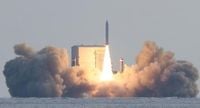South Korea is setting its sights on the moon with an ambitious plan to establish a lunar base by 2045, marking a bold step forward in the nation’s space exploration efforts. This vision was unveiled by the Korea AeroSpace Administration (KASA) during a public hearing held at the National Research Foundation of Korea in Daejeon on July 17, 2025.
The new roadmap outlines a comprehensive strategy for Korea’s space activities, dividing exploration into four key areas: Earth orbit, the moon, the heliosphere, and deep space. Central to this strategy are five core missions, including low-Earth orbit and microgravity exploration, lunar exploration, and solar and space science missions.
In the lunar sector, KASA plans to develop advanced technologies for independent landing and mobility on the moon’s surface. The roadmap emphasizes harnessing lunar resources and building the necessary infrastructure to support economic activities, a sign that Korea is not just interested in scientific discovery but also in the commercial potential of the moon.
By 2040, the administration aims to develop a next-generation lunar lander designed to handle logistics, paving the way for a sustainable presence. The ultimate goal is to construct a lunar economic base by 2045, which would represent a significant milestone in Korea’s space ambitions and position the country as a key player in the future of lunar exploration.
Alongside lunar ambitions, KASA is also focusing on solar and heliosphere exploration. The roadmap calls for the development of probes to monitor solar activity, which is crucial for enhancing space safety and protecting satellites and astronauts from solar storms. One notable mission includes deploying a solar observation satellite to the Lagrange point L4 by 2035. This point, where the gravitational forces of the sun and Earth balance out, offers a stable vantage point for continuous solar monitoring.
These plans come on the heels of South Korea’s recent successes in space technology. For instance, on June 21, 2022, the homegrown Nuri rocket was launched from the Naro Space Center in South Jeolla’s Goheung County, showcasing Korea’s growing capability in rocket technology. Furthermore, on December 4, 2023, South Korea achieved a significant milestone by successfully launching a solid-fuel space rocket from a barge floating about four kilometers south of Jeju Island. This launch placed a small Earth observation satellite into orbit at an altitude of approximately 650 kilometers, demonstrating the country’s expanding expertise in satellite deployment and orbital operations.
These developments reflect South Korea’s rapid progress in space exploration, fueled by a growing desire to join the ranks of leading spacefaring nations. The roadmap’s emphasis on combining scientific research with economic development signals a strategic approach that balances innovation with practical benefits.
Experts note that Korea’s lunar ambitions align with a broader international trend toward establishing a sustained human presence on the moon. Countries like the United States, China, and members of the European Space Agency have all announced plans to build lunar bases or conduct extended missions on the moon. South Korea’s plan to build a lunar economic base by 2045 fits neatly into this emerging global framework, potentially opening doors for collaboration and competition alike.
Moreover, the focus on developing independent landing and mobility technology is crucial. Successfully navigating the lunar surface and transporting materials and equipment will be essential for establishing a functional base. KASA’s roadmap suggests that Korea is investing heavily in these technologies, which could have spillover benefits for other areas of space exploration and even terrestrial industries.
The solar observation mission to Lagrange point L4 is another intriguing aspect of the roadmap. Monitoring solar activity from this unique vantage point could provide early warnings of solar storms that threaten satellites and power grids on Earth. This mission underscores Korea’s commitment to space safety and its recognition of the interconnectedness between space weather and life on Earth.
South Korea’s space ambitions are also a reflection of its broader technological and economic aspirations. By 2045, the nation hopes not only to have a physical presence on the moon but also to have catalyzed new industries and economic opportunities stemming from lunar resource utilization and space-based infrastructure.
While the timeline is ambitious, Korea’s recent achievements in rocket launches and satellite deployment suggest that the country has the technical foundation to pursue these goals. The launch of the Nuri rocket and the successful barge-based rocket launch near Jeju Island demonstrate a steady buildup of expertise and confidence in Korea’s space capabilities.
As the world watches, South Korea’s roadmap to the moon represents a significant chapter in the country’s journey toward becoming a major spacefaring nation. The combination of scientific exploration, economic development, and space safety initiatives paints a picture of a comprehensive and forward-thinking strategy.
With the goal of establishing a lunar economic base by 2045, South Korea is not just aiming for the stars but planning to build a home there, potentially transforming the future of space exploration and economic activity beyond Earth.

